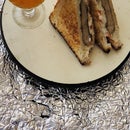Introduction: Crispy French Fries ( 1kg/hr)
While I was doing my course at Harvard about science and cooking I came across a fabulous technique taught by my teacher Dan Souza. He taught us to make BEST FRENCH FRIES.
The equipments were the regular ones but what was different was the technique.
MORE LIKE A NEVER SEEN BEFORE TECHNIQUE
The equipments were the regular ones but what was different was the technique.
MORE LIKE A NEVER SEEN BEFORE TECHNIQUE
Supplies
Hot oil for deep frying
A thermometer (optional but recommended)
Russet potatoes / chipsona in case India.
A wok or deep fryer.
A spider or fryer basket.
A thermometer (optional but recommended)
Russet potatoes / chipsona in case India.
A wok or deep fryer.
A spider or fryer basket.
Step 1:
We eat French fries all the time, all over the place. And we don't give much thought to how they're made. The truth is that the science behind French fries and frying in general is more complicated than you might think. And it all has to do with temperature. The classic recipe for fries with the crispy exterior and creamy interiors calls for frying the potatoes twice. Now, the first frying at a low temperature, usually 250 to 275 degrees Fahrenheit, gently cooks the potatoes through so that the centers turn creamy. Now, the second frying at 350 to 375 degrees Fahrenheit crisps the exterior and creates that brown crust that makes fries so tasty. In hot oil, water trapped in the potato turns to steam and escapes. Now, we've all seen bubbles produced as soon as we place food in hot fat. The oil isn't boiling. It's just moisture escaping. Now, when steam escapes, it leaves small holes behind, which then fill with oil.
The amount of oil that a French fry absorbs is directly proportional to the amount of water that exits.
If the oil doesn't get hot enough to drive off sufficient moisture and then take its place, we run into two big problems.
First, the exterior of the fry never climbs above the boiling point of water, which is 212 degrees Fahrenheit. For a brown, flavorful crust to form, we need
to reach at least 300 degrees Fahrenheit for browning reactions such as caramelization and the Maillard reaction to really kick into gear. Second, if the outer crust isn't able to crisp and absorb a sufficient amount of oil, there's little to keep the moisture that's still in the potato from migrating to the outer edge and turning it soggy. So hot oil is clearly important for frying but frying french fries, draining them, reheating the oil, and frying them again,
it's pretty cumbersome and messy. It's not something you really want to do at home, especially if you have to do it in batches in order to make enough fries.
The amount of oil that a French fry absorbs is directly proportional to the amount of water that exits.
If the oil doesn't get hot enough to drive off sufficient moisture and then take its place, we run into two big problems.
First, the exterior of the fry never climbs above the boiling point of water, which is 212 degrees Fahrenheit. For a brown, flavorful crust to form, we need
to reach at least 300 degrees Fahrenheit for browning reactions such as caramelization and the Maillard reaction to really kick into gear. Second, if the outer crust isn't able to crisp and absorb a sufficient amount of oil, there's little to keep the moisture that's still in the potato from migrating to the outer edge and turning it soggy. So hot oil is clearly important for frying but frying french fries, draining them, reheating the oil, and frying them again,
it's pretty cumbersome and messy. It's not something you really want to do at home, especially if you have to do it in batches in order to make enough fries.
Step 2:
To prevent all the fuss Harvard we were told of a method that eliminates this hassle by simply throwing sliced potatoes into a pot of room temperature oil and turning on the heat. As the oil warms, the interior cooks through and water begins to escape from the potato, just as it
would in the traditional first fry. As the oil continues to heat up, the fries begin to crisp and brown. This part of the process mimics the second high heat fry.
Note the image of straining french fries is that of when I first time tried this recipe. The pieces are fat. Try not to make very fat french fries.
would in the traditional first fry. As the oil continues to heat up, the fries begin to crisp and brown. This part of the process mimics the second high heat fry.
Note the image of straining french fries is that of when I first time tried this recipe. The pieces are fat. Try not to make very fat french fries.
Step 3:
Now, you may be thinking that if potatoes go into cold oil and then spend almost 30 minutes frying, they must contain more oil than traditionally cooked fries. In fact, the very opposite is true. Now, remember that oil absorption is directly proportional to moisture escape. This gentler frying method, where the oil never gets much above 300 degrees, drives off a lot less water. That translates to roughly 1/3 less absorbed oil. So not only are these fries easier to make, they're also healthier to eat.

Participated in the
1 Hour Challenge











